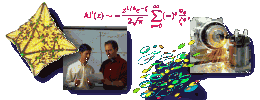Simulating spin waves in ultra-cold quantum gases
James Williams
Electron and Optical Physics Division, Physics Laboratory, NIST
Thursday, May 8, 2003 15:00-16:00,
Room 145, NIST North (820)
Gaithersburg
Thursday, May 8, 2003 13:00-14:00,
Room 4550
Boulder
Abstract:
The incredibly long coherence times of atomic hyperfine states make them
ideally suited for frequency standards and quantum information processing.
Recent experiments on quantum gases have utilized this cherished trait of
cold atoms for the study of spin waves, a property usually associated with
solid-state materials rather than dilute atomic gases. Researchers in the
Quantum Physics Division of of NIST observed this effect in a gas of
rubidium-87 atoms cooled just above the transition for Bose-Einstein
condensation. On the theory side, we teamed up with them for a detailed
study of the excitation frequencies and damping rates of the collective
spin modes. More recently, we have extended our work to the Bose-condensed
regime, which is an uncharted direction for theory with a wealth of new
physics to be discovered. In this talk I will mainly concentrate on the
numerical modeling aspect of the problem, and outline some of the remaining
challenges we face in extending our model to describe the coupled
condensate
and normal gas dynamics.
Contact: A. J. KearsleyNote: Visitors from outside NIST must contact
Robin Bickel; (301) 975-3668;
at least 24 hours in advance.
|




